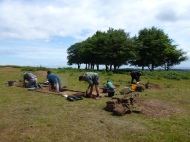The Hinkley Point Archaeology Outreach team have been helping experts from the South West Heritage Trust and Quantock Hills AONB Service, to learn more about Cothelstone Hill’s fascinating past, funded by a grant from the Heritage Lottery Fund (HLF) Sharing Heritage Programme The hill has a wealth of archaeological features including Bronze Age round barrows, Iron Age dyke, Medieval pillow mounds and the remains of an 18th century folly.
An archaeological dig took place over the weekend of 20th and 21st June, to better understand the nature of the features on the hilltop and to find a place to plant a replacement clump of trees, that will eventually replace the iconic Seven Sisters trees when they finally fall. The excavation yielded flint implements including arrowheads and blades which were made and discarded by people living in the later Stone Age.
Students from Bridgwater College had the opportunity of working on the excavation, helping to uncover the secrets of this beautiful hill on the Quantocks. A class of children from Bishops Lydeard primary school also came out to gain some ‘hands on’ experience.
An open weekend was held on 20th and 21st June and families and dog walkers were able to meet the archaeological team, view some of the finds and take part in guided walks across the hill. Hinkley Point is visible from the top of the hill and the outreach team were able to tell visitors about the excavations and show replicas of the Wick Barrow beakers discovered nearby.
To find out more about the Quantock Hills go to http://www.quantockhills.com/











